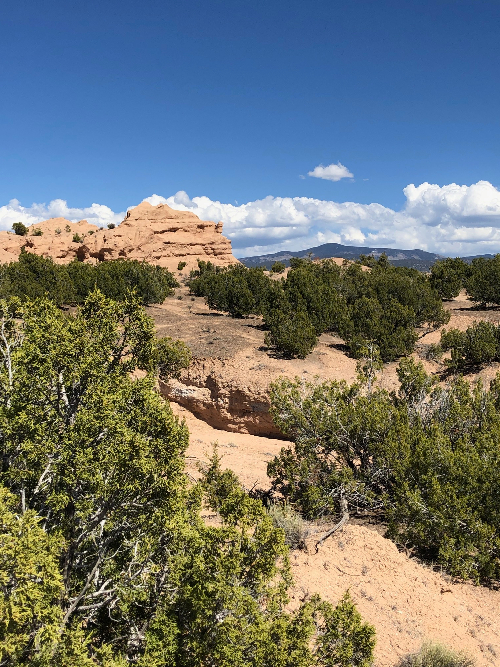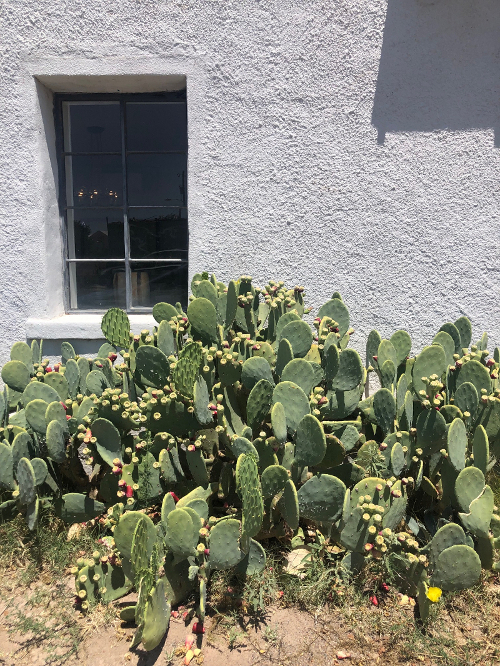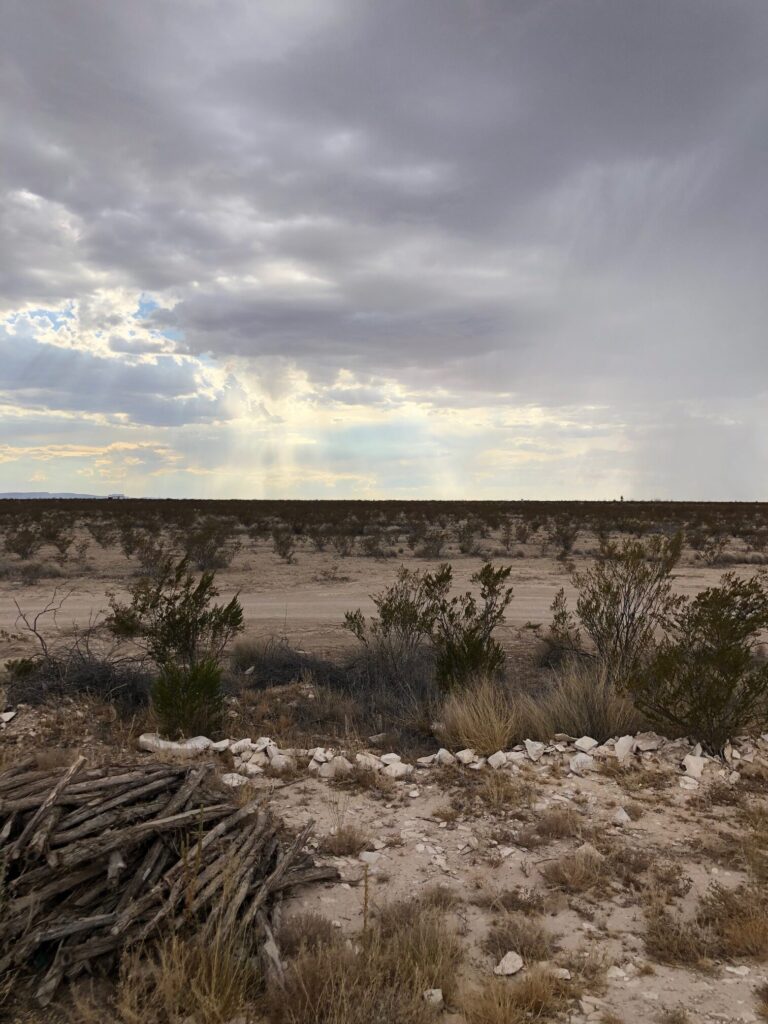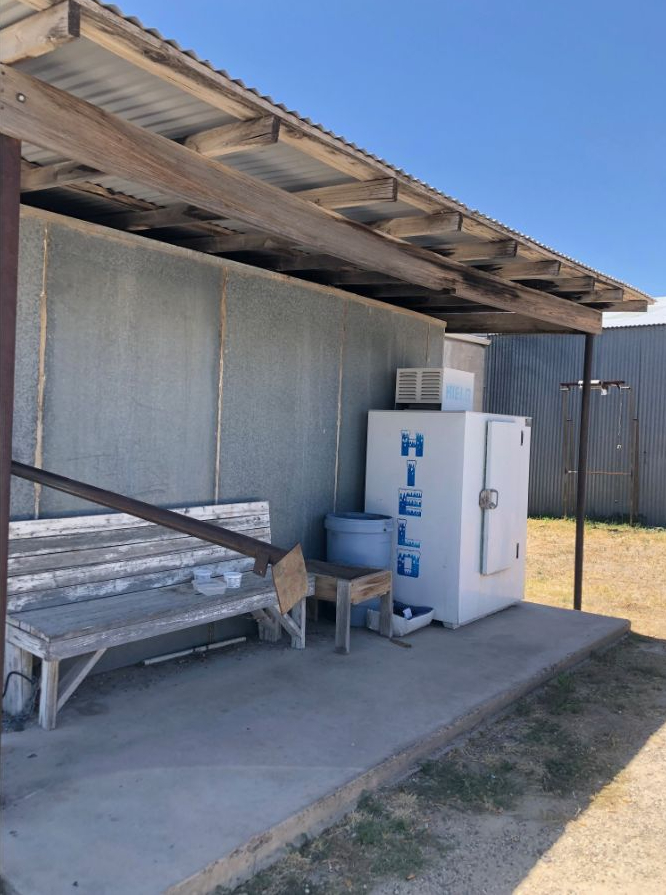by Sarah Hassan
Bleached rock juts out from the pale sand of the desert like the undulating fingers of a giant. A lone, disoriented figure appears on screen, the dot of his grimy red baseball cap like a pushpin on the map.
Soon we will hear the desperate crunch of ice and the electrical buzz of a two-bit operating room. Then the hum of Nowhere calls, and the figure continues on. The open road, the endless ribbon of asphalt that snakes through the southwest, takes the place of the wine-dark sea for our mute Odysseus.
Blinking neon will follow the silver glint of railroad tracks, and the sad overhead glow of a diner will illuminate a reunion, before the hot orange sunset leads them to California. There will be a line of polished candy-colored shoes, the scuffed robin’s egg paint of a Ford Ranchero, the metallic shine of a child’s jacket, and a string of twinkling Christmas lights leading to a chlorine-blue lit hallway.
There, the flash of rose-pink lips crowned by bleached blonde hair awaits behind a closed door. Darkness will come again, deep and knowing as it does in this part of the country, and then a stillness. An alien-green streetlamp envelopes our reluctant hero a final time and with the single pluck of a guitar string, the road calls on in the wake of a mother’s embrace, with or without ever-lasting love.

Wim Wenders’ magnum opus to the colors and allure of the American west and the wreckage of a romance gone wrong, Paris, Texas has been written about to an almost breathless degree. With its mythological premise — a wandering man searches for his family and redemption amidst the glitter and tumbleweeds of the desert — the film inspires debate, obsession, and a dissection of each scene that gets stamped on the subconscious of practically every viewer. It’s the kind of film that begs for a proper theater, the landscape too wide and vast, the colors too hot and saturated to be fenced in.
You may never have seen the film, but there is a good chance you know the image of Nastassja Kinski as Jane, in her now-iconic backless pink sweater — bought, of all places, at a garage sale in Port Arthur — as she gazes dreamily into the one-way mirror separating her and her estranged husband, Travis, the mournful Harry Dean Stanton, at the oddest of Texan peep shows.
It seems absurd to celebrate the film even more, to praise the near-miraculous acting, the unforgettable dialogue penned by Sam Shepard, the Ed Ruscha cum Gordan Parks sensibility to Robby Müller’s cinematography, the haunting twang of Ry Cooder’s guitar weaving itself through each scene, and so on and so on. Now, forty years after it debuted at the Cannes Film Festival and won the coveted Palme d’or, Paris, Texas has undergone a new 4K restoration, bringing the ballad of Travis & Jane back to life for another round of dust-covered heartache and an old-fashioned road trip.

In the current moment, when the zeitgeist fawns over a new breed of nostalgic Americana and cowboy cool, Paris, Texas feels almost freshly subversive. Staggering through the desert borderlands for four years in a hallucinatory state, Travis emerges like a beat idol without pretense. We feel every ache and blistering patch of sunburned skin on his weather-beaten face as he contemplates his continued escape, the mystery of his origin story somehow too painful to contemplate — and only later will we find that it is, indeed, almost too painful to believe. The workwear is worn in earnest, the classic cars driven out of necessity, and the stark side of a building advertising hardware / ranch / electrical supplies hand-painted long before Instagram showed up to capture it.
It’s easy to forget in this new iteration, where the colors are even brighter, the bluest sky you’ve ever seen somehow bluer, that Paris, Texas was filmed four decades ago. Drive through any small town off of Highway 10 and you’ll still see those same signs, those same pastel-hued rock formations, the same plaid shirts and creased Levi’s on anyone stopped at a gas station, the horizon that same electric orange hidden under a heavy passel of violet-grey storm clouds egging you onward.
Forty years after Wenders started filming in August of 1983, I found myself in those very same towns he decamped in. On the way to Marfa with a friend — another mythological destination for anyone wanting to see the concrete squares of Donald Judd in their natural shrub grass habitat — I stopped in places such as Fort Stockton, Lajitas, Terlingua, and Marathon, the latter two where Travis attempts to continue on his desert walkabout after his brother, Walt, tries in vain to reintroduce him to civilization via a roadside motel.
Fort Stockton, with its abandoned adobe buildings and empty parking lots, presented itself like a ready-made movie set. I bought slabs of marbled steaks and sweet corn from a small shop bearing an ice machine out back so perfect I nearly expected the ghost of Harry Dean to appear dressed in his dirt-caked suit.
Barreling towards Marathon, a local high school advertised a sold-out rodeo and a five-mile-long train — something Wenders made great strides to capture during their once-a-day pass through his filming locations — stopped my friend and I behind a pickup truck at the crossing. The driver had the longest handlebar mustache I’d ever seen, getting out to throw his hat down in frustration at the rust-colored cars bearing ‘SANTA FE’ as they chugged slowly past us.
We drove on through miles and miles of Nothing, the ticker tape image of green grass, knotty white clouds and a sky streaked low with the coming sunset, the stuff that road films depend on.
Four years is a long time — “half a boys life” Travis chuckles when Walt confronts him over his absence and the mark it left on his young son, Hunter — but four years earlier I had moved to the southwest, charmed by the same Nothing as quickly as my coastal self could handle. In the midst of a global crisis, it was easy to understand the siren song of that landscape and its ability to swallow you whole, ask no questions. I found myself walking, alone like Travis, for miles along sun-baked, unmarked roads where the only sound I heard was my own ragged breathing, walking until I lost the plot, and turned back around. Whatever was out there I felt had to be better than this, the uncertainty and pain, the inconceivable truth of what was happening to the world.
Paris, Texas is the fabled Ithaca of the film, existing only in a worn-out photograph showing a parcel of land purchased in the mail where Travis dreams of one day raising his family. It’s a running joke, a lost cause, but still it persists in his mind, a piece of his past he can’t shake, the dream of something whole in the aftermath of heart-wrenching violence.
Who among us has loved so fiercely as to tie our beloved to a stove, or to set him on fire? What capacity does the human heart have for such pain when the pleasure has died and then relegates itself to a one-way mirror concealing a stranger you once loved? “Every man has your voice,” Jane admits in the film, tear-streaked into an intercom with her back turned from Travis, the man she escaped from only to end up in a room talking to men she’ll never know. It’s a mad kind of longing, but a longing many can recognize, the comfort of one who ripped your life apart and then believed lost forever. We tell ourselves stories to live, but sometimes we need a ghost to tell them to first.
For forty years, Paris, Texas has been a cinematic meditation on longing. Travis longs for his family, Hunter longs for his father, and then his mother, Walt and his wife, Anne, long for stability, and Jane longs for the release of what being a mother did to her so she can be a mother once more.
‘Timeless’ is a word often used for any artwork that speaks to subsequent generations, but with Paris, Texas, it’s almost the point. Fathers still abandon their sons, mothers still struggle to dream, and the desert endures whoever crosses into her badlands looking for amnesia or disappearance. Every scene, from Travis gazing into his own reflection framed by Jane’s hands, to Hunter and Travis matching each other’s comical gaits as they lope along on the walk home, feels like lightning in a bottle. The tapestry of human emotion is rich throughout — elation, guilt, despair, loneliness, desire, petulance — reminding us that we too, can become the Travis in our story, asking the questions, or eventually the Jane, listening for answers.
After he stops Travis on the side of the road for the second time, Walt tries to convince his then-mute brother with a shake of his head towards the empty horizon that “there’s nothing out there.” It seems pointless to Walt that Travis keeps walking — Walking to where, exactly? Towards what? — but viewing this scene, and all the others that came after, in more brilliant color decades later in a darkened theater, I finally knew what was out there, what keeps us all walking and what illuminates the great and terrible landscape of our own mysterious heartbreak — hope.

Sarah Hassan is a writer and bean counter for the antiquarian book trade. Her work has appeared in The Thieving Magpie, Architectural Digest, Treats!, Playboy, The Coveteur and extensively in Harper’s Bazaar Arabia: Art. She currently lives in New York City, but is always plotting her escape back to the desert.



Love this writer!!!
Beautiful.